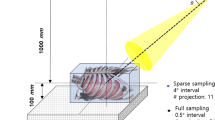Zusammenfassung
In computed tomography (CT), data truncation is a common problem. Images reconstructed by the standard filtered back-projection algorithm from truncated data suffer from cupping artifacts inside the field-of-view (FOV), while anatomical structures are severely distorted or missing outside the FOV. Deep learning, particularly the U-Net, has been applied to extend the FOV as a post-processing method. Since image-to-image prediction neglects the data fidelity to measured projection data, incorrect structures, even inside the FOV, might be reconstructed by such an approach. Therefore, generating reconstructed images directly from a post-processing neural network is inadequate. In this work, we propose a data consistent reconstruction method, which utilizes deep learning reconstruction as prior for extrapolating truncated projections and a conventional iterative reconstruction to constrain the reconstruction consistent to measured raw data. Its efficacy is demonstrated in our study, achieving small average root-mean-square error of 24HU inside the FOV and a high structure similarity index of 0.993 for the whole body area on a test patient’s CT data.
Access this chapter
Tax calculation will be finalised at checkout
Purchases are for personal use only
Preview
Unable to display preview. Download preview PDF.
Similar content being viewed by others
Literatur
Hsieh J, Chao E, Thibault J, et al. A novel reconstruction algorithm to extend the CT scan field-of-view. Med Phys. 2004;31(9):2385–2391.
Xia Y, Hofmann H, Dennerlein F, et al. Towards clinical application of a Laplace operator-based region of interest reconstruction algorithm in C-arm CT. IEEE Trans Med Imaging. 2013;33(3):593–606.
Noo F, Clackdoyle R, Pack JD. A two-step Hilbert transform method for 2D image reconstruction. Phys Med Biol. 2004;49(17):3903–3923.
Kudo H, Courdurier M, Noo F, et al. Tiny a priori knowledge solves the interior problem in computed tomography. Phys Med Biol. 2008;53(9):2207.
Yu H, Wang G. Compressed sensing based interior tomography. Phys Med Biol. 2009;54(9):2791.
Schwab J, Antholzer S, Haltmeier M. Deep null space learning for inverse problems: convergence analysis and rates. Inverse Probl. 2019;.
Han Y, Ye JC. One network to solve all ROIs: Deep learning CT for any ROI using differentiated backprojection. arXiv. 2018;.
Li Y, Li K, Zhang C, et al. Learning to reconstruct computed tomography (CT) images directly from sinogram data under a variety of data acquisition conditions. IEEE Trans Med Imaging. 2019;8:2469–2481.
Maier AK, Syben C, Stimpel B, et al. Learning with known operators reduces maximum training error bounds. Nat Mach Intell. 2019;.
Fournié É, Baer-Beck M, Stierstorfer K. CT Field of View Extension Using Combined Channels Extension and Deep Learning Methods. Proc MIDL. 2019;.
Huang Y, Wür T, Breininger K, et al. Some investigations on robustness of deep learning in limited angle tomography. Proc MICCAI. 2018; p. 145–153.
Huang Y, Taubmann O, Huang X, et al. Scale-space anisotropic total variation for limited angle tomography. IEEE Trans Radiat Plasma Med Sci. 2018;2(4):307–314.
Author information
Authors and Affiliations
Corresponding author
Editor information
Editors and Affiliations
Rights and permissions
Copyright information
© 2020 Springer Fachmedien Wiesbaden GmbH, ein Teil von Springer Nature
About this paper
Cite this paper
Huang, Y., Gao, L., Preuhs, A., Maier, A. (2020). Field of View Extension in Computed Tomography Using Deep Learning Prior. In: Tolxdorff, T., Deserno, T., Handels, H., Maier, A., Maier-Hein, K., Palm, C. (eds) Bildverarbeitung für die Medizin 2020. Informatik aktuell. Springer Vieweg, Wiesbaden. https://doi.org/10.1007/978-3-658-29267-6_40
Download citation
DOI: https://doi.org/10.1007/978-3-658-29267-6_40
Published:
Publisher Name: Springer Vieweg, Wiesbaden
Print ISBN: 978-3-658-29266-9
Online ISBN: 978-3-658-29267-6
eBook Packages: Computer Science and Engineering (German Language)




